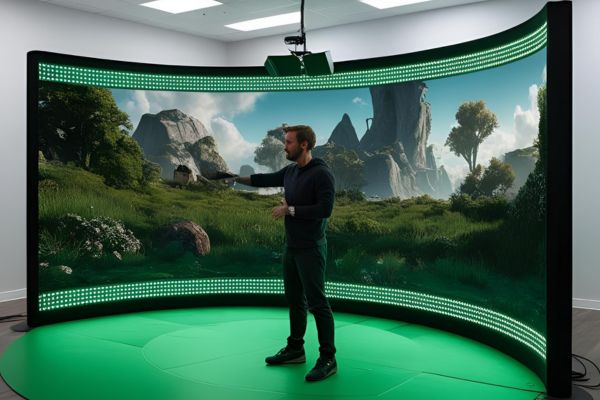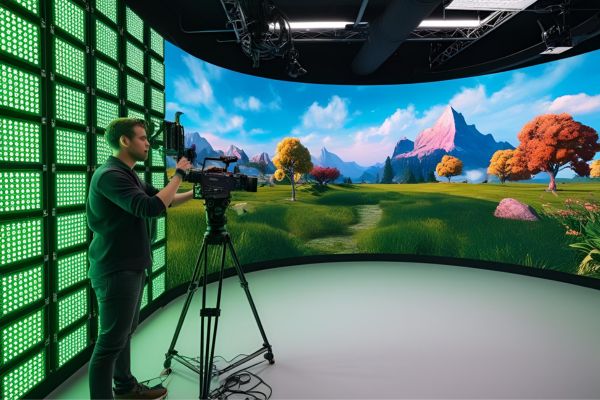Filmmaking has always been a complex and resource-intensive process, requiring extensive travel, set construction, and post-production work. However, the rise of virtual production is revolutionizing how movies and TV shows are made. This technology, which integrates real-time computer-generated environments with live-action footage, is allowing filmmakers to work more efficiently while expanding creative possibilities. According to a report by MarketsandMarkets, the global virtual production market is projected to grow from $2.6 billion in 2022 to $5.1 billion by 2027, reflecting the industry’s rapid adoption of this technology.

What is Virtual Production?
Virtual production uses digital environments, LED walls, and real-time rendering software to create immersive, lifelike backgrounds that replace traditional green screens. With tools like Unreal Engine, filmmakers can visualize entire scenes before shooting, reducing the need for physical set construction. A survey by the Visual Effects Society found that over 70% of VFX-heavy productions now utilize virtual production methods to streamline production.
How Virtual Production Works
The core of virtual production lies in combining several technologies:
- LED Walls and Real-Time Rendering – Instead of using green screens, massive LED walls display photorealistic digital environments, allowing actors to interact with dynamic backgrounds in real time.
- Motion Capture and Augmented Reality – Advanced tracking systems map the movement of actors and objects, integrating them seamlessly into digital environments.
- Game Engine Technology – Real-time rendering engines enable filmmakers to adjust lighting, backgrounds, and effects on set, eliminating the need for extensive post-production work.
How Virtual Production is Transforming Filmmaking
Replacing Traditional Sets with Digital Environments
Traditionally, filmmakers relied on physical sets and extensive on-location shoots, which added logistical challenges and high costs. With virtual production, entire worlds can be digitally created and displayed on massive LED walls. This eliminates travel expenses while providing more control over lighting and weather conditions. The British Film Institute estimates that a typical film production generates 2,840 metric tons of CO₂, much of which comes from location-based filming. Virtual production significantly reduces this environmental impact.

Cutting Down Production Time and Costs
One of the most significant advantages of virtual production is its ability to reduce production costs and timelines. A Deloitte study found that studios using virtual production can cut location-based expenses by 40-50% and post-production time by 30%. By rendering backgrounds in real time, filmmakers can adjust settings instantly, eliminating the need for costly reshoots and complex post-production edits.
Enhancing Realism and Creative Flexibility
With LED walls projecting hyper-realistic landscapes, virtual production offers a level of immersion that traditional green screens cannot. This allows actors to interact more naturally with their surroundings, leading to better performances. The American Society of Cinematographers reports that 85% of cinematographers prefer virtual production for its ability to provide realistic lighting and depth perception, making it easier to compose shots dynamically.
Making Filmmaking More Accessible to Independent Creators
Virtual production was once reserved for big-budget studios, but as the technology advances, independent filmmakers are gaining access to these tools. The cost of virtual production setups is gradually decreasing, with smaller studios adopting LED volume stages and real-time rendering engines. According to PwC, the availability of cloud-based virtual production tools is expected to increase by 60% over the next five years, making it a viable option for a broader range of creators.

Reducing the Environmental Impact of Filmmaking
The shift to virtual production is not only a financial advantage but also a sustainability game-changer. Traditional film shoots require travel, physical sets, and excessive energy consumption. With digital environments, filmmakers can cut down on waste and carbon emissions. A study by Albert, a UK-based sustainability group, found that virtual production can reduce a film’s carbon footprint by up to 90% compared to traditional methods.
The Future of Virtual Production
With advancements in AI, real-time rendering, and cloud-based production, virtual production is set to become an industry standard. 5G technology will further enable remote collaboration, allowing directors, editors, and VFX artists to work together seamlessly across different locations. As major studios invest in expanding virtual production infrastructure, its role in the future of filmmaking is undeniable.
Virtual Production is Transforming Film Industry
Virtual production is transforming the film industry by offering a more cost-effective, time-efficient, and environmentally friendly approach to filmmaking. The rapid adoption of this technology, coupled with its potential for enhancing creativity and accessibility, is paving the way for a new era in storytelling. As AI, real-time rendering, and cloud-based tools continue to evolve, virtual production will become a cornerstone of modern filmmaking, shaping the industry’s future for years to come.




